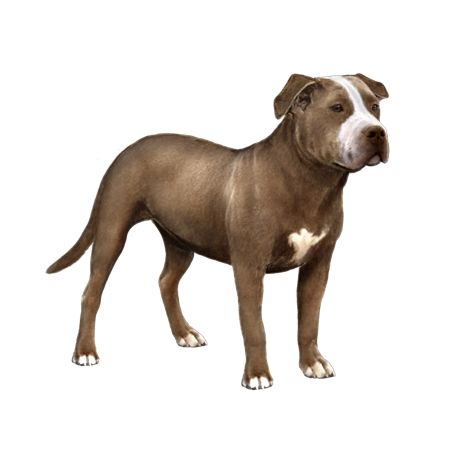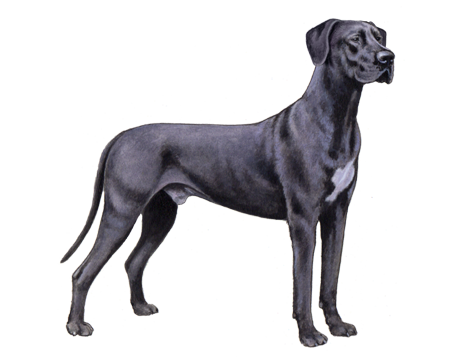
American Staffordshire Terrier
Though known as a courageous and powerful breed, the American Staffordshire Terrier is also affectionate and loyal. Loving toward family members and excellent with children, these pups make calm, fun-loving household companions when responsibly bred and properly cared for.
Interested in discovering if your dog is an American Staffordshire Terrier?
Check out Wisdom Panel's DNA tests.

American Staffordshire Terrier Traits
General Appearance
American Staffordshire Terriers are sturdy, agile, and highly aware of their surroundings. The breed exudes strength with a muscular body, broad skull, and powerful jaw.
Coat and Colouring
The AmStaff's coat is short, shiny, and stiff to the touch. This breed can be any color with solid, parti-color, or patched black, brown, tan, brindle (black and brown striped), liver, red, or fawn. Black or blue mask and brindle are common in American Staffordshire Terriers. Dogs that are all white, more than 80% white, black and tan, and liver are not encouraged in the breed standard.
Distinctive Physical Traits
American Staffordshire Terriers are known for their well-defined, strong jaws. Their eyes are round, set far apart on the face, and typically dark. And their uncropped ears are short and held half prick or rose (an ear shape that resembles the petals of a rose).
AmStaffs have a stocky build and are heavy for their size. They have relatively short, low-set tails that taper to a point.
American Staffordshire Terrier Temperament
American Staffordshire Terriers are very loyal to their families and usually good with children.
Known as intelligent, hard-working, and stoic, AmStaffs make excellent guard dogs. Though they're good-natured, they may be protective of their families. That said, they're not aggressive unless provoked.
American Staffordshire Terriers can be suspicious of people they don't know. And they may not get along well with unfamiliar dogs or small pets. Early socialization and training can help them be friendly toward other animals and strangers.


American Staffordshire Terrier History
The American Staffordshire Terrier (or AmStaff, for short) dates back to 19th-century England—when various terriers were crossed with the Bulldog. The courageous and powerful dogs that resulted excelled in the fighting pit. But they also showed great talent as guard dogs and livestock herders.
These pit bulls came to America in the late 1800s. And though some were used for fighting, many became fixtures both on the frontier and at home—thanks to their hard-working, gentle nature. Still, most kennel clubs were hesitant to recognize dogs associated with fighting.
Though the American Pit Bull Terrier received United Kennel Club recognition at the turn of the century, breeders in the U.S. set out to develop a related but distinct breed. They focused their breeding programs on increasing the pit bull's size and weight.
This effort led to the Staffordshire Terrier, which the AKC recognized in 1936. When the AKC later recognized the Staffordshire Bull Terrier from England in 1972, they decided to add “American” to the Staffordshire Terrier’s name to clearly delineate between the two breeds.
Today, most AmStaffs live as peaceful, gentle family members. They've earned a great reputation and excel in many roles—including guarding, police work, and agility.
American Staffordshire Terrier Care
Nutrition
American Staffordshire Terriers thrive on a high-quality diet that's appropriate for their life stage. Feeding a large-breed puppy formula can help keep your AmStaff pup from growing too fast and developing painful hip dysplasia later in life.
Take care to monitor how much your dog eats and reduce portions if they gain too much weight. And remember to count calories from treats. As a general rule, they should make up no more than 10% of a dog's caloric intake.
Grooming
The American Staffordshire Terrier's short coat and light shedding make it a very low-maintenance breed in terms of grooming. Weekly brushing with a soft-bristled brush and an occasional bath is usually all these dogs need.
Keep in mind that all pups require regular dental care—including at-home teeth brushing and professional dental cleanings.
Exercise
American Staffordshire Terriers need daily exercise, whether that's a leashed walk, short run, or backyard game of fetch. But when exercising your AmStaff outdoors in the winter, be sure to keep your sessions relatively brief. Their short coats are not suited for chilly weather. (That said, fashionable sweaters can help!)
Strong and athletic, AmStaffs also seem to enjoy dog sports—such as agility, flyball, and rally. Competitive obedience training is another great option that not only reinforces desired behaviors but also provides your dog with mental exercise.
Training
Obedient and relatively easy to train, AmStaff Terriers benefit from firm, dedicated training to temper their guarding tendencies. But remember: They can be stubborn and may not respond well to forceful training methods. So, positive, reward-based training is the best way to help this intelligent breed learn quickly.

American Staffordshire Terrier Genetic Health Conditions
-
Canine Multifocal Retinopathy 1
Canine Multifocal Retinopathy 1 (CMR1) is an eye disorder that can cause retinal decay which may impact vision, but very rarely results in blindness.
-
Chondrodystrophy (CDDY) and Intervertebral Disc Disease (IVDD) Risk
Chondrodystrophy (CDDY) is a skeletal disorder characterized by shortened limbs and abnormal early degeneration of the spinal discs, or intervertebral disc disease (IVDD), which predisposes to disc herniation.
-
Cone-Rod Dystrophy 1
Cone-Rod Dystrophy (CRD1) is an eye disorder resulting in degeneration of the retina at the back of the eye at a young age, causing progressive vision loss.
-
Hereditary Calcium Oxalate Urolithiasis, Type 1
Hereditary Calcium Oxalate Urolithiasis, Type 1 (CaOx1) is a genetic disorder that greatly increases the risk for urinary stones composed of calcium oxalate to form within the kidneys or bladder.
-
Hyperuricosuria
Hyperuricosuria (HUU) is a condition that predisposes affected dogs to the formation of urinary stones, such as kidney or bladder stones.
-
Osteochondromatosis (Discovered in the American Staffordshire Terrier)
Osteochondromatosis is a condition causing benign bone tumors, called osteochondromas, to form during puppyhood.
Knowing if your American Staffordshire Terrier is a carrier or at-risk for these conditions can help you and your veterinarian plan for your pup's lifelong care. With Wisdom Panel™ Premium, you can get results for over 200 genetic health tests.
Breed Group
Guard
Dogs of the Guard Group were bred to guard people and property. They are often quick to learn and these intelligent, capable animals make solid companions.
Resources
https://www.rover.com/blog/american-staffordshire-terrier-fun-facts-and-myths-vs-reality/
https://www.akc.org/dog-breeds/american-staffordshire-terrier/
https://vcahospitals.com/know-your-pet/dog-breeds/american-staffordshire-terrier
http://www.fci.be/Nomenclature/Standards/286g03-en.pdf
https://www.akc.org/expert-advice/dog-breeds/american-staffordshire-terrier-history-amstaff/
Reviewed 26 July 2020 by Cindy Elston, DVM, MPH























